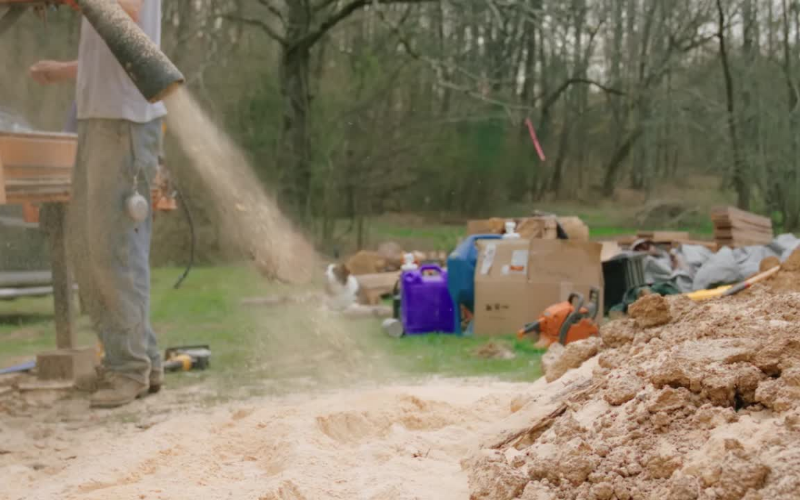Using sawdust as a soil amendment, mulch, or primary bedding material can be an attractive option. Sawdust is cheap, completely biodegradable, and easy to handle. It’s hard to ignore these benefits but you might still be wondering, “Will sawdust kill grass over time? If it was this simple, why aren’t more people using it?” These are valid questions. To get the full answer, you may need to ask a few more.

Will Sawdust Kill Grass?
No, sawdust will not kill grass. On its own and in small quantities, sawdust should not kill grass unless that sawdust is from wood that had been treated with a herbicide or other toxic chemical treatment.
Is sawdust harmful to grass if applied in large quantities? Of course. Anything piled on top of your lawn so that no light can reach the blades of grass will smother your lawn. This is, however, a great way to lie down paths and create flowerbeds without having to cut up any sod. After a few weeks the grass will die down and plants can be set directly into the top layer of sawdust with little digging required.
Related Article: What Kills Grass? A Comprehensive List
Does Sawdust Kill Grass and Weeds?
Sawdust has no inherent herbicide or pesticide qualities unless it is from wood that was treated with these substances. However, spreading a layer of wet sawdust just 1/2″ thick over an area of grass or weeds cut low to the ground can help control these plants by blocking out the sun and encouraging decay.
Is Sawdust Good for the Grass?
As stated above, sawdust is cheap and can be versatile in the garden. However, does sawdust provide these same benefits to lawns?
Does Sawdust Make a Good Mulch?
If you are attempting to seed a lawn, sawdust makes an excellent cover mulch provided it stays about 1/4″ thick all over the area. Any thicker than this and the sawdust may bind when wet and mat together.
Can Sawdust Be Used as a Lawn Fertilizer?
Sawdust is a lot like wood mulch or any other wood-type soil amendment. It takes a lot to break it down and it doesn’t add much nitrogen to the soil by volume. For example, sprinkling sawdust on a lawn will result in a smaller nitrogen gain that allowing your grass clippings to break down where they lie.
Is Sawdust a Good Soil Amendment for Lawns?
If you want to add nutrients or aeration, sawdust is not the soil amendment for you. First, sawdust is a “cool” substance in terms of compost. This means it is low in nitrogen and breaks down slowly. As lawns eat up more nitrogen than most other types of plants or planting arrangements, liquid fertilizer is often a better choice.
If you are looking to work something in for aeration, sawdust has too fine of a particle size and may lead to further compaction given its lack of rigidity or structure. Sawdust also has a neutral pH in most cases. All-in-all there are far better soil amendments than sawdust for lawns.

How Long Does Sawdust Take to Decompose?
There are three main factors used to determine how long sawdust will take to decompose on your lawn. First, you have moisture. The more moisture is involved, the faster the sawdust will break down and be able to provide a small amount of nitrogen to your lawn. Heat also helps speed up the decomposition process in the presence of moisture.
Particle size is the final determining factor. The smaller each piece of sawdust is, the faster it will break down. Depending on all of these conditions, sawdust can take as little as 2 months to decompose or it could take as long as several years.
How Do You Get Sawdust Out of Grass?
Whether it’s dry or wet, there are three main options to get sawdust out of your lawn. The first option is to remove the sawdust by hand. This is easiest to do if the sawdust is damp. Second, you could use a broom or rake to remove the sawdust in a similar manner.
The easiest method to choose would be to use a wet-dry vacuum or “shop” vac meant for picking up sawdust from floors. None of these methods should harm your lawn. As long as no remaining sawdust can shade the underlying blades of grass, that sawdust will break down over time with no ill effects.
Sawdust Can Be a Great Tool, Just Not a Great Amendment
Sawdust isn’t a bad thing to sprinkle on your lawn, but it’s also not a particularly effective or attractive option for most intents and purposes. That doesn’t mean it’s useless, though.
Keeping some sawdust on hand is a great idea in case you need something absorbent to mitigate a spill. In cases like this sawdust can do a fair amount of damage control. Alternatively, you may have a patch of weeds to kill or maybe a bare spot that needs re-seeding. There are plenty of ways to use sawdust around the yard, just not as a fertilizer or soil amendment.


Leave a Reply